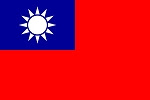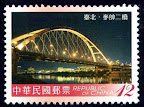
Stamp Issue : 2012-09-12
Located in the Emei Township of Hsinchu County, Emei Lake, also known as Tapu reservoir was built in 1960. With an area of 135 hectares, Emei Lake was primarily used for irrigation. During the construction of the reservoir, five suspension bridges were specially built to facilitate the traffic across the lake shores. Due to wear and tear and the need for road widening, cement bridges are built to replace the old bridges. Today, only the Shimaopu Suspension Bridge is left for pedestrians use and is now generally referred as Emei Lake Suspension Bridge.
The suspension bridge is 2.5 meters wide and about 100 meters long. The entrance at both ends is connected by two sturdy cables which to each end, there are three large cables fastened to anchorages constructed by cement stones to increase the support for the load of the bridge deck for safety. Under the main cable, suspended are the smaller cables to hold the weight of the pedestrian trails built by wood.
峨眉湖又名大埔水庫,建於民國49年,儲水面積135公頃, 地處新竹縣峨眉鄉境為一灌溉為主之水庫。水庫興建時,特別修築五座吊橋方便兩岸往來交通,後因道路的拓寬與舊橋的損壞,之後均改以水泥橋替代,現今只剩下細茅埔吊橋供人行走,一般亦改稱該橋為峨眉湖吊橋。
吊橋寬兩點五十公尺,長約一百公尺,兩條堅固的纜繩連接於二端的吊橋入口處,每端各有三條大纜繩,再以水泥石塊固定住纜繩,增加吊橋的承受力,避免危險,在大纜繩主幹之下,再以較細小的纜繩來做為支持人行步道的重量,腳下所踏的是木板。
吊橋寬兩點五十公尺,長約一百公尺,兩條堅固的纜繩連接於二端的吊橋入口處,每端各有三條大纜繩,再以水泥石塊固定住纜繩,增加吊橋的承受力,避免危險,在大纜繩主幹之下,再以較細小的纜繩來做為支持人行步道的重量,腳下所踏的是木板。























